1) What is the final result of mitosis in a human?
A)
genetically identical 1n somatic cells B) genetically identical 2n
somatic cells
C) genetically identical 2n gamete cells D)
genetically different 2n somatic cells
B)
2) Some cells have several nuclei per cell. How could such multinucleated cells be explained?
A) The cell underwent repeated cytokinesis but no
mitosis.
B) The cell underwent repeated mitosis with
simultaneous cytokinesis.
C) The cell had multiple S phases
before it entered mitosis.
D) The cell underwent repeated
mitosis, but cytokinesis did not occur.
D)
3) FtsZ is a bacterial cytoskeletal protein that forms a contractile ring involved in bacterial cytokinesis. Its function is analogous to _____.
A) the microtubule-organizing center of eukaryotic cells
B)
the cleavage furrow of eukaryotic animal cells
C) the mitotic
spindle of eukaryotic cells
D) the cell plate of eukaryotic
plant cells
B)
4) Movement of the chromosomes during anaphase would be most affected
by a drug that prevents _____.
A) nuclear envelope breakdown
B) shortening of microtubules
C) elongation of microtubules
D) formation of a cleavage furrow
B)
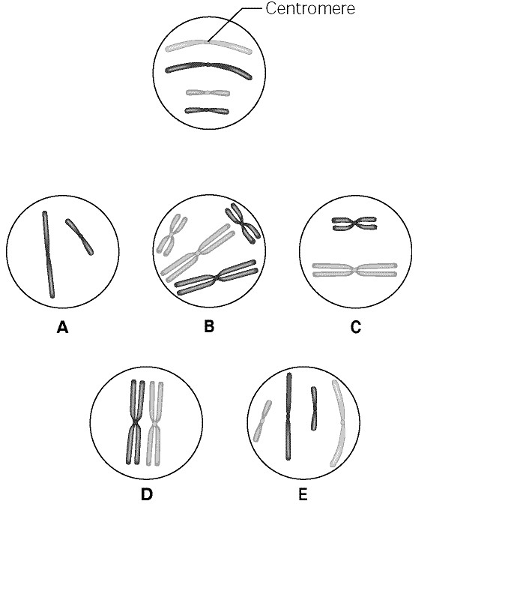
Use the following information to answer the questions below.
The
unlettered circle at the top of the figure shows a diploid nucleus
with four chromosomes that have not yet replicated. There are two
pairs of homologous chromosomes, one long and the other short. One
haploid set is black, and the other is gray. The circles labeled A to
E show various combinations of these chromosomes.
5) What is the correct chromosomal condition for one daughter nucleus at telophase of mitosis?
A) B B) C C) D D) E
D)
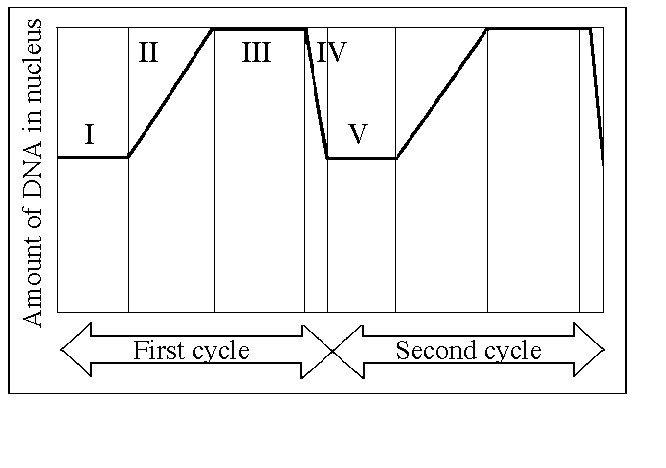
6) In the figure above, G1 is represented by which numbered part(s) of the cycle?
A) I or V B) II or IV C) III only D) V only
A)
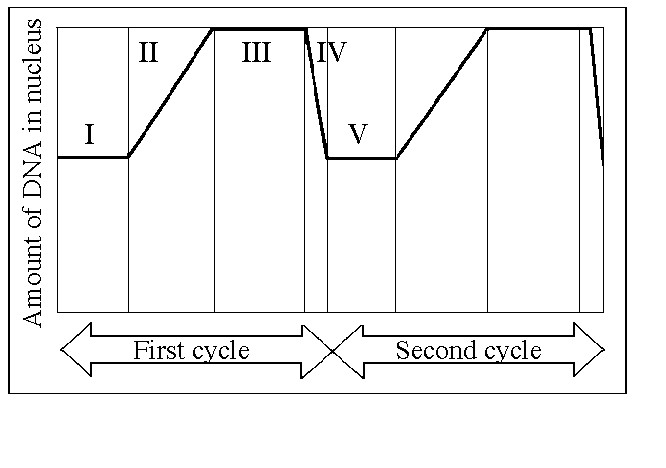
7) In the figure above, which number represents DNA synthesis?
A) I B) II C) III D) IV
B)
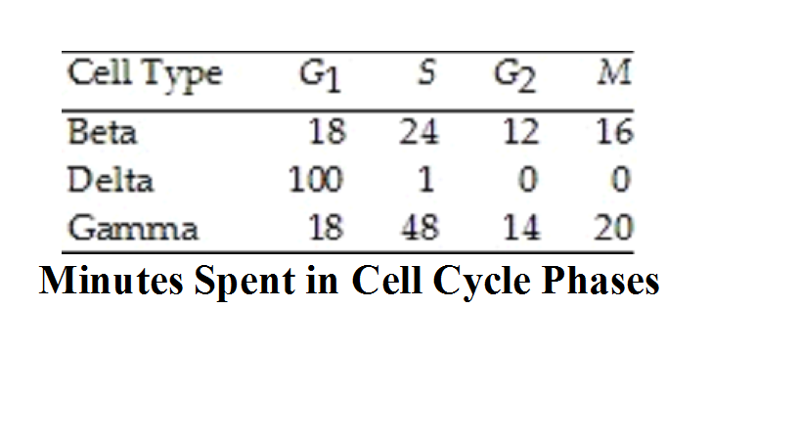
Use the data in the accompanying table to answer the following
questions.
The data were obtained from a study of the length of
time spent in each phase of the cell cycle by cells of three
eukaryotic organisms designated beta, delta, and gamma.
Minutes Spent in Cell Cycle Phases
8) Of the following, the best conclusion concerning the difference between the S phases for beta and gamma is that ____.
A) gamma contains more DNA than beta
B) beta is a plant
cell and gamma is an animal cell
C) beta and gamma contain the
same amount of DNA
D) beta cells reproduce asexually
A)
Use the following information to answer the questions
below.
Nucleotides can be radiolabeled before they are
incorporated into newly forming DNA and, therefore, can be assayed to
track their incorporation. In a set of experiments, a student—faculty
research team used labeled T nucleotides and introduced these into the
culture of dividing human cells at specific times.
9) The research team used their experiments to study the incorporation of labeled nucleotides into a culture of lymphocytes and found that the lymphocytes incorporated the labeled nucleotide at a significantly higher level after a pathogen was introduced into the culture. They concluded that _____.
A) infection causes lymphocytes to divide more rapidly
B)
infection causes lymphocyte cultures to skip some parts of the cell
cycle
C) infection causes cell cultures in general to reproduce
more rapidly
D) the presence of the pathogen made the experiments
too contaminated to trust the results
A)
10) The drug cytochalasin B blocks the function of actin. Which of the following aspects of the cell cycle would be most disrupted by cytochalasin B?
A) spindle attachment to kinetochores
B) cleavage furrow
formation and cytokinesis
C) spindle formation
D) cell
elongation during anaphase
B)
11) Density-dependent inhibition is explained by which of the following?
A) As cells become more numerous, the protein kinases they
produce begin to compete with each other, such that the proteins
produced by one cell essentially cancel those produced by its
neighbor.
B) As cells become more numerous, the level of waste
products increases, eventually slowing down metabolism.
C) As
cells become more numerous, the cell surface proteins of one cell
contact the adjoining cells and they stop dividing.
D) As cells
become more numerous, they begin to squeeze against each other,
restricting their size and ability to produce control factors.
C)
12) Exposure of zebrafish nuclei to meiotic cytosol resulted in phosphorylation of NEP55 and L68 proteins by cyclin-dependent kinase 2. NEP55 is a protein of the inner nuclear membrane, and L68 is a protein of the nuclear lamina. What is the most likely role of phosphorylation of these proteins in the process of mitosis?
A) They are involved in the disassembly and dispersal of the
nucleolus.
B) They enable the attachment of the spindle
microtubules to kinetochore regions of the centromere.
C) They
are involved in the disassembly of the nuclear envelope.
D) They
assist in the movement of the centrosomes to opposite sides of the nucleus.
C)
13) Cells from advanced malignant tumors often have very abnormal chromosomes and an abnormal number of chromosomes. What might explain the association between malignant tumors and chromosomal abnormalities?
A) Cancer cells are no longer anchorage-dependent.
B)
Cancer cells are no longer density-dependent.
C) Cell cycle
checkpoints are not in place to stop cells with chromosome
abnormalities.
D) Transformation introduces new chromosomes into cells.
C)
14) Quaking aspen can send out underground stems for asexual reproduction. Sexual reproduction is not as common, but when it does happen, the haploid gametes have 19 chromosomes. How many chromosomes are in the cells of the underground stems?
A) 19 B) 38 C) 10 D) 9
B)
15) Which of the following is true of a species that has a chromosome number of 2n = 16?
A) Each diploid cell has eight homologous pairs.
B) The
species is diploid with 32 chromosomes per cell.
C) A gamete
from this species has four chromosomes.
D) The species has 16
sets of chromosomes per cell.
A)
16) Eukaryotic sexual life cycles show tremendous variation. Of the
following elements, which do all sexual life cycles have in
common?
I. Alternation of generations II. Meiosis III.
Fertilization IV. Gametes V. Spores
A) II, III, and IV
B) I, II, III, IV, and V
C) II, IV, and V
D) I, II, and IV
A)
17) In a human karyotype, chromosomes are arranged in 23 pairs. If we
choose one of these pairs, such as pair 14, which of the following do
the two chromosomes of the pair have in common?
A) length,
centromere position, and staining pattern only
B) length and
position of the centromere only
C) length, centromere position,
staining pattern, and traits coded for by their genes
D) They
have nothing in common except that they are X-shaped.
C)
18) How do cells at the completion of meiosis compare with cells that
are in prophase of meiosis I? They have _____.
A) the same
number of chromosomes and half the amount of DNA.
B) half the
number of chromosomes and half the amount of DNA.
C) half the
amount of cytoplasm and twice the amount of DNA.
D) half the
number of chromosomes and one-fourth the amount of DNA.
D)
19) If meiosis produces haploid cells, how is the diploid number
restored for those organisms that spend most of their life cycle in
the diploid state?
A) fertilization B) DNA replication C)
synapsis D) reverse transcription
A)
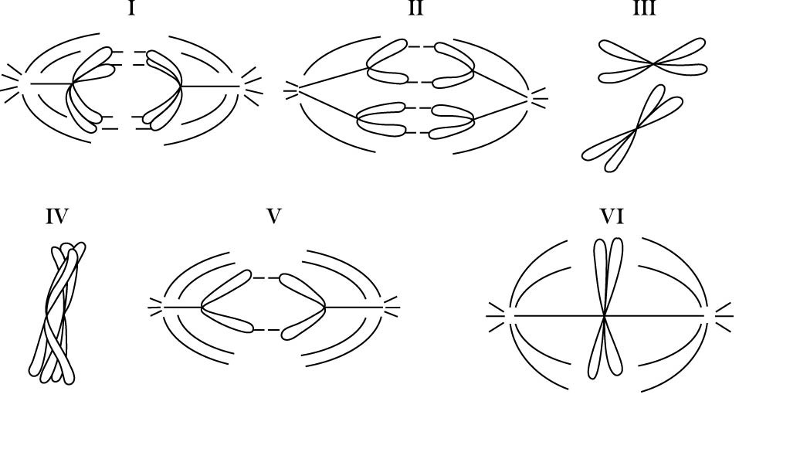
Refer to the drawings in the figure below of a single pair of homologous chromosomes as they might appear during various stages of either mitosis or meiosis, and answer the following questions.
20) Which diagram represents anaphase I of meiosis?
A) I
B) II
C) IV
D) V
A)
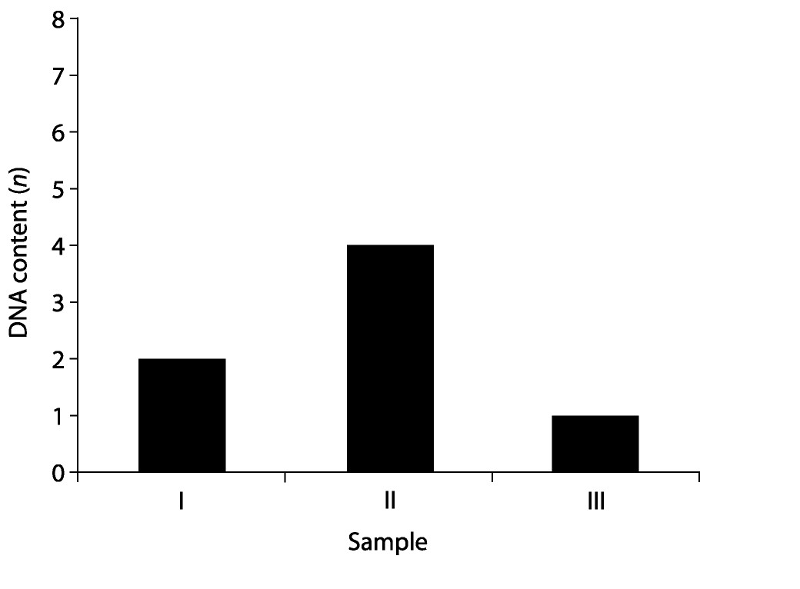
You have isolated DNA from three different cell types of the same organism, determined the relative DNA content for each type, and plotted the results on the graph shown in the figure below. Refer to the graph to answer the following question(s).
21) Which sample might represent an animal cell in the G2 phase of the cell cycle?
A) I
B) II
C) III
D) both I and II
B)
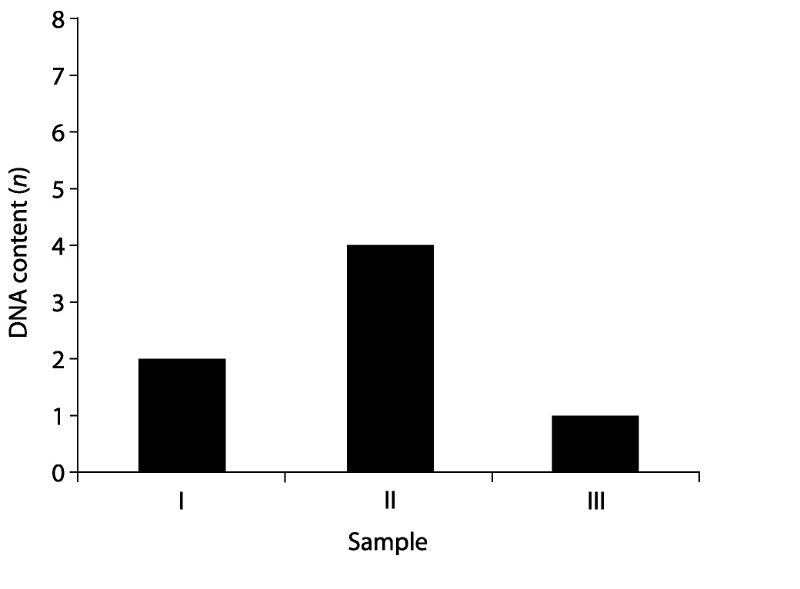
22) Which sample might represent a zygote?
A) I
B) II
C) III
D) either I or II
A)
23) Imagine that there are twenty-five different species of protists living in a tide pool. Some of these species reproduce both sexually and asexually, and some of them can reproduce only asexually. The pool gradually becomes infested with disease-causing viruses and bacteria. Which species are more likely to thrive in the changing environment?
A) the asexually reproducing species
B) Sexually and
asexually reproducing species are equally likely to thrive.
C)
the sexually reproducing species
C)
24) How is natural selection related to sexual reproduction as opposed to asexual reproduction?
A) Sexual reproduction utilizes far less energy than asexual
reproduction.
B) Sexual reproduction results in the greatest
number of new mutations.
C) Sexual reproduction results in many
new gene combinations, some of which will lead to differential
reproduction.
D) Sexual reproduction allows the greatest number
of offspring to be produced.
C)

25) A certain female's number 12 chromosomes both have the blue gene and number 19 chromosomes both have the long gene. As cells in her ovaries undergo meiosis, her resulting eggs (ova) may have which of the following?
A) either one blue or one orange gene in addition to either one
long or one short gene
B) either two number 12 chromosomes with
blue genes or two with orange genes
C) one chromosome 12 with
one blue gene and one chromosome 19 with one long gene
D) either
two number 19 chromosomes with long genes or two with short genes
C)

26) If a female of this species has one chromosome 12 with a blue
gene and another chromosome 12 with an orange gene, and has both
number 19 chromosomes with short genes, she will produce which of the
following egg types?
A) three-fourths blue short and one-fourth
orange short gene eggs
B) only orange short gene eggs
C)
only blue short gene eggs
D) one-half blue short and one-half
orange short gene eggs
D)
27) What was the most significant conclusion that Gregor Mendel drew from his experiments with pea plants?
A) Genes are composed of DNA.
B) There is considerable genetic
variation in garden peas.
C) Traits are inherited in discrete
units and are not the results of "blending."
D)
Recessive genes occur more frequently in the F1 generation than do
dominant ones.
C)
28) How many unique gametes could be produced through independent assortment by an individual with the genotype AaBbCCDdEE?
A) 64 B) 4 C) 16 D) 8
D)
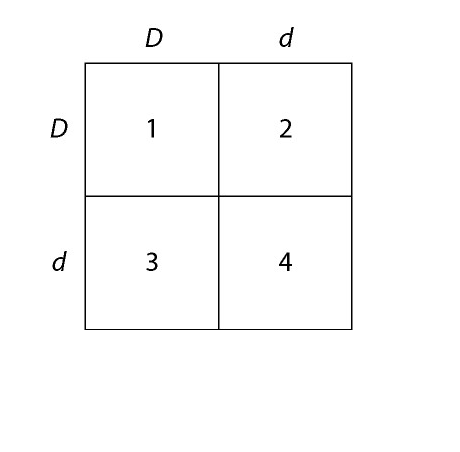
Use the figure and the following description to answer the question(s) below.
In a particular plant, leaf color is controlled by gene locus D. Plants with at least one allele D have dark green leaves, and plants with the homozygous recessive dd genotype have light green leaves. A true-breeding, dark-leaved plant is crossed with a light-leaved one, and the F1 offspring is allowed to self-pollinate. The predicted outcome of the F2 is diagrammed in the Punnett square shown in the figure, where 1, 2, 3, and 4 represent the genotypes corresponding to each box within the square.
29) Which of the boxes marked 1-4 correspond to plants with dark leaves?
A) 1 only B) 4 only C) 2 and 3 D) 1, 2, and 3
D)
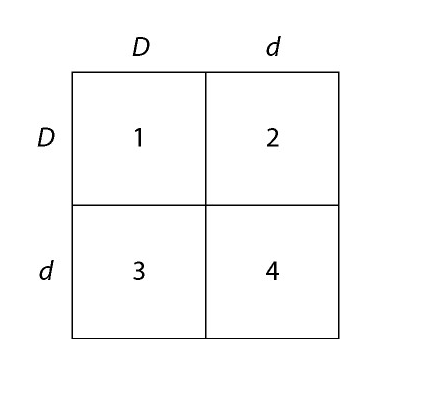
30) Which of the boxes marked 1-4 correspond to plants that will be true-breeding?
A) 1 only B) 2 and 3 only C) 1 and 4 only D) 1, 2, 3, and 4
C)
31) In cattle, roan coat color (mixed red and white hairs) occurs in the heterozygous (Rr) offspring of red (RR) and white (rr) homozygotes. Which of the following crosses would produce offspring in the ratio of 1 red:2 roan:1 white?
A) red × white B) red × roan C) roan × roan D) white × roan
C)
32) Two true-breeding stocks of pea plants are crossed. One parent has red, axial flowers and the other has white, terminal flowers; all F1 individuals have red, axial flowers. The genes for flower color and location assort independently. Among the F2 offspring, what is the probability of plants with white axial flowers?
A) 1/4 B) 9/16 C) 3/16 D) 1/16
C)
33) When Mendel crossed yellow-seeded and green-seeded pea plants, all the offspring were yellow seeded. When he took these F1 yellow-seeded plants and crossed them to green-seeded plants, what genotypic ratio was expected?
A) 1:1 B) 1:1:1:1 C) 1:2:1 D) 3:1
A)
34) Gene S controls the sharpness of spines in a type of cactus. Cactuses with the dominant allele, S, have sharp spines, whereas homozygous recessive ss cactuses have dull spines. At the same time, a second gene, N, determines whether or not cactuses have spines. Homozygous recessive nn cactuses have no spines at all. The relationship between genes S and N is an example of _____.
A) incomplete dominance
B) codominance
C) epistasis
D) pleiotropy
C)
35) Gene S controls the sharpness of spines in a type of cactus. Cactuses with the dominant allele, S, have sharp spines, whereas homozygous recessive ss cactuses have dull spines. At the same time, a second gene, N, determines whether or not cactuses have spines. Homozygous recessive nn cactuses have no spines at all. A cross between a true-breeding sharp-spined cactus and a spineless cactus would produce_____.
A) 25% sharp-spined, 50% dull-spined, 25% spineless progeny
B) all sharp-spined progeny
C) 50% sharp-spined, 50% dull-spined progeny
D) It is impossible to determine the phenotypes of the progeny.
B)
36) In some parts of Africa, the frequency of heterozygosity for the
sickle-cell anemia allele is unusually high, presumably because this
reduces the frequency of malaria. Such a relationship is related to
which of the following?
A) Mendel's law of segregation B)
Mendel's law of independent assortment
C) Darwin's explanation of
natural selection D) the malarial parasite changing the allele
C)
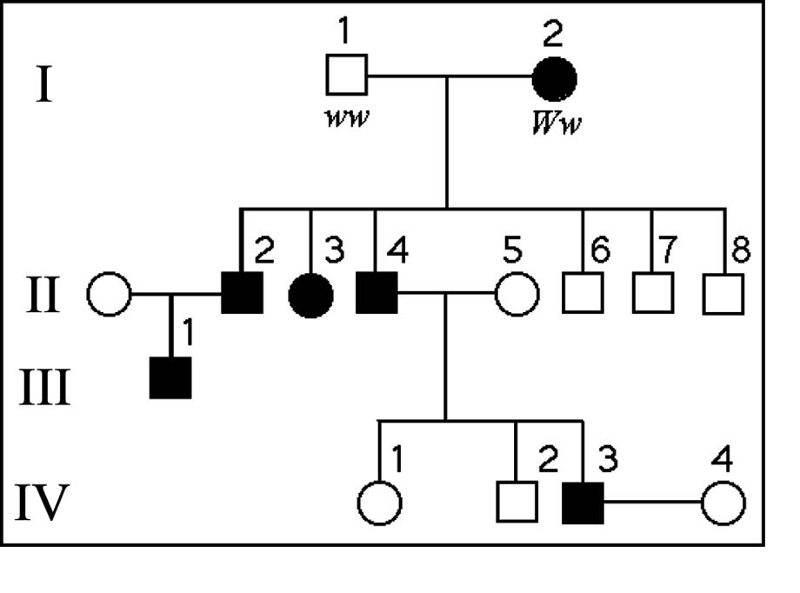
The following questions refer to the pedigree chart in the figure below for a family, some of whose members exhibit the dominant trait, W. Affected individuals are indicated by a dark square or circle.
37) What is the genotype of individual II-5?
A) Ww
B) WW
C) ww
D) ww or Ww
C)
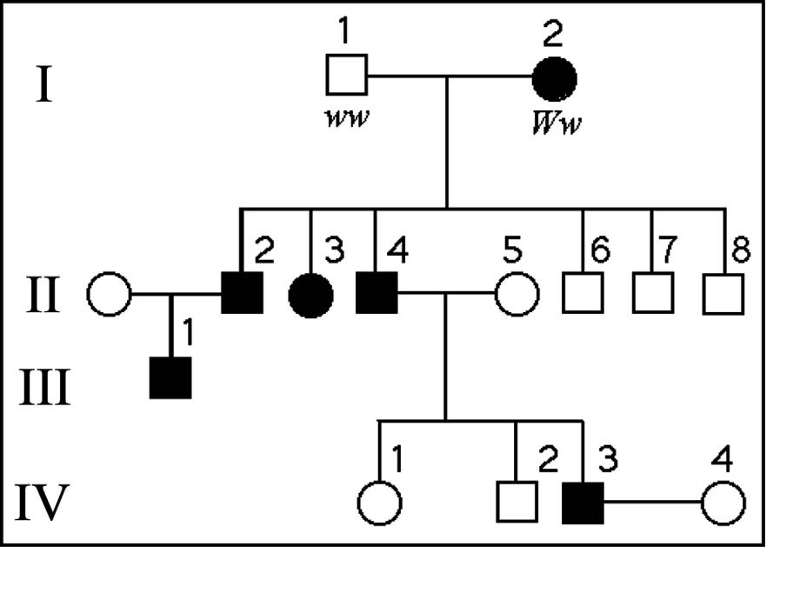
38) What is the likelihood that the progeny of IV-3 and IV-4 will have the trait?
A) 50% B) 0% C) 75% D) 100%
A)
39) Marfan syndrome in humans is caused by an abnormality of the connective tissue protein fibrillin. Patients are usually very tall and thin, with long spindly fingers, curvature of the spine, sometimes weakened arterial walls, and sometimes ocular problems, such as lens dislocation. Which of the following would you conclude about Marfan syndrome from this information?
A) It is dominant. B) It is epistatic. C) It is pleiotropic. D) It is recessive.
C)
40) Males are more often affected by sex-linked traits than females because _____.
A) males are hemizygous for the X chromosome
B) male
hormones such as testosterone often alter the effects of mutations on
the X chromosome
C) X chromosomes in males generally have more
mutations than X chromosomes in females
D) female hormones such
as estrogen often compensate for the effects of mutations on the X chromosome
A)
41) In cats, black fur color is caused by an X-linked allele; the other allele at this locus causes orange color. The heterozygote is tortoiseshell. What kinds of offspring would you expect from the cross of a black female and an orange male?
A) black females; orange males
B) orange females; black males
C) tortoiseshell females; tortoiseshell males
D) tortoiseshell females; black males
D)
42) Sex determination in mammals is due to the SRY gene. Which of the following could allow a person with an XX karyotype to develop a male phenotype?
A) the loss of the SRY gene from an autosome
B)
translocation of SRY to a X chromosome
C) a person with one
normal and one shortened (deleted) X
D) a person with an extra
autosomal chromosome
B)
43) Duchenne muscular dystrophy is a serious condition caused by a recessive allele of a gene on the human X chromosome. The patients have muscles that weaken over time because they have absent or decreased dystrophin, a muscle protein. They rarely live past their twenties. How likely is it for a woman to have this condition?
A) One-fourth of the daughters of an affected man would have this
condition.
B) Only if a woman is XXX could she have this
condition.
C) One-half of the daughters of an affected father and
a carrier mother could have this condition.
D) Women can never
have this condition.
C)
44) What does a frequency of recombination of 50% indicate?
A) The genes are located on sex chromosomes.
B) The two
genes are likely to be located on different chromosomes.
C)
Abnormal meiosis has occurred.
D) All of the offspring have
combinations of traits that match one of the two parents.
B)

45) In a Drosophila experiment, a cross was made between homozygous
wild-type females and yellow-bodied males. All of the resulting F1s
were phenotypically wild type. However, adult flies of the F2
generation (resulting from matings of the F1s) had the characteristics
shown in the figure above. Consider the following questions:
(a)
Is the mutant allele for yellow body recessive or dominant?
(b)
Is the yellow locus autosomal (not X-linked) or X-linked?
A) (a) recessive; (b) X-linked
B) (a) dominant; (b) not X-linked
C) (a) dominant; (b) X-linked
D) (a) recessive; (b) not X-linked
A)

The following is a map of four genes on a chromosome.
46)
Between which two genes would you expect the highest frequency of recombination?
A) A and G
B) A and E
C) E and G
D) A and W
A)
47) If cell X enters meiosis, and nondisjunction of one chromosome occurs in one of its daughter cells during meiosis II, what will be the result at the completion of meiosis?
A) Two of the four gametes descended from cell X will be haploid,
and two will be diploid.
B) Half of the gametes descended from
cell X will be n + 1, and half will be n - 1.
C) 1/4 of the
gametes descended from cell X will be n + 1, 1/4 will be n - 1, and
1/2 will be n.
D) All the gametes descended from cell X will be diploid.
C)
48) A phenotypically normal prospective couple seeks genetic counseling because the man knows that he has a translocation of a portion of his chromosome 4 that has been exchanged with a portion of his chromosome 12. Although his translocation is balanced, he and his wife want to know the probability that his sperm will be abnormal. What is your prognosis regarding his sperm?
A) 1/2 will be normal and the rest will have the father's translocation.
B) 1/4 will carry the two normal chromosomes, 4 and 12, 1/4 will have only the two translocation chromosomes and no normal chromosomes 4 and 12, and 1/2 will have both normal and translocated chromosomes.
C) None will carry the translocation.
D) All will carry the same translocation as the father.
B)
49) Glucose-6-phosphate dehydrogenase deficiency (G6PD) is inherited
as a recessive allele of an X-linked gene in humans. A woman whose
father suffered from G6PD marries a normal man.
(a) What
proportion of their sons is expected to be G6PD?
(b) If the
husband was not normal but was G6PD deficient, would you change your
answer in part (a)?
A) (a) 1/2; (b) yes
B) (a) 100%; (b) no
C) (a) zero; (b) no
D) (a) 1/2; (b) no
D)
50) What is an adaptive advantage of recombination between linked genes?
A) Recombination is required for independent assortment.
B)
The forces on the cell during meiosis II results in
recombination.
C) Recombination must occur or genes will not
assort independently.
D) New allele combinations are acted upon
by natural selection.
D)